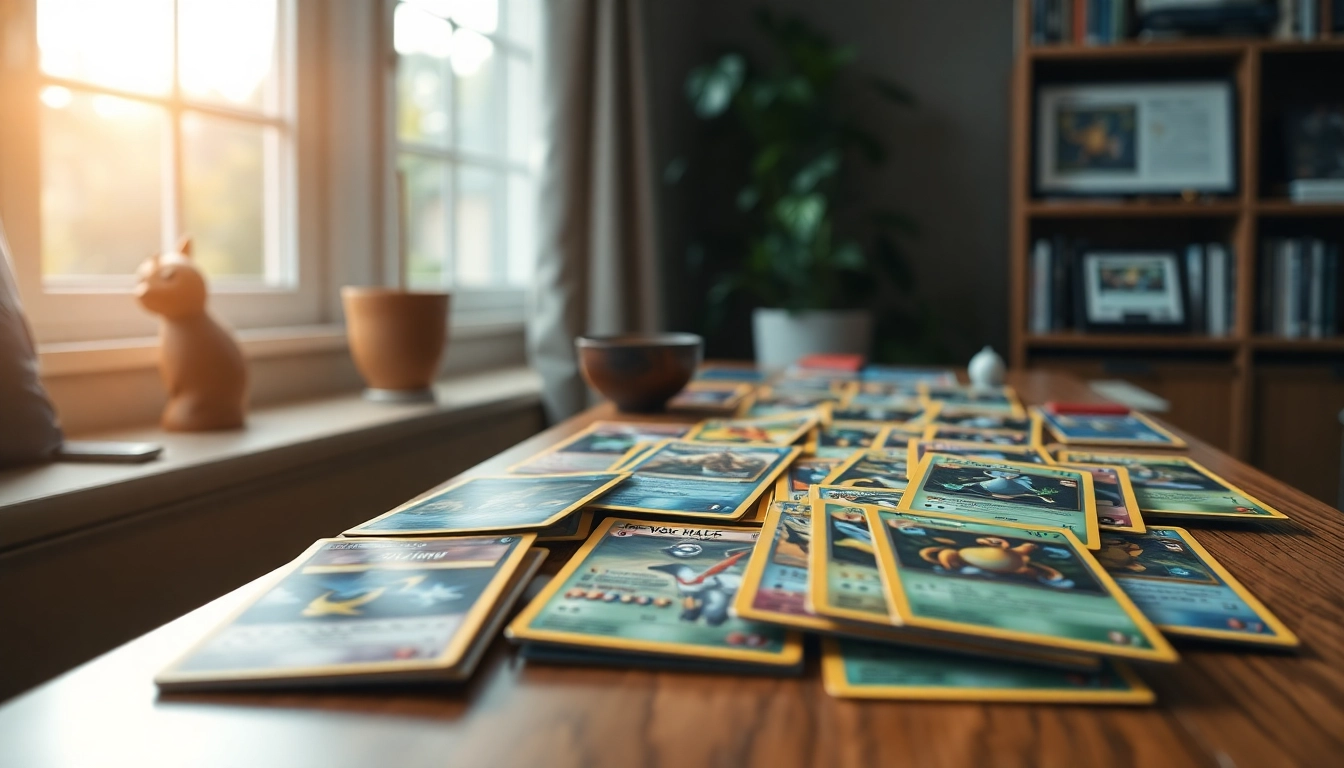Understanding Real Pokémon Cards
In the vibrant and ever-expanding world of Pokémon, the allure of collecting real Pokémon cards continues to captivate fans and collectors alike. As the market grows, it becomes increasingly vital to discern the authenticity of these collectibles. A significant aspect of this journey involves identifying what truly constitutes a real Pokémon card and recognizing the implications of owning genuine versus counterfeit versions. This guide dives deep into what makes Pokémon cards authentic, the common signs of fakes, and the importance of authenticity in the collecting arena.
What Makes Pokémon Cards Authentic?
Authentic Pokémon cards are recognized for their quality and features that set them apart from counterfeit products. The authenticity of a Pokémon card can be established through several key factors:
- Material Quality: Real Pokémon cards are made from high-quality cardstock that feels sturdy yet flexible. Fake cards often use inferior materials that can feel flimsy or overly glossy.
- Printing and Color: Authentic cards showcase vibrant, rich colors and clear printing. Look for any blurriness or misalignment in the text and images, as these are strong indicators of counterfeit cards.
- Holographic Features: Many real Pokémon cards feature holographic elements that change appearance depending on the angle of light. These holograms are complex and difficult to replicate, making them a solid indicator of authenticity.
- Ruler Test: A common way to check authenticity is to measure the card’s dimensions. Official Pokémon cards adhere to specific sizes, typically 2.5 x 3.5 inches. Variations can indicate a fake.
- Weight: Genuine Pokémon cards have a consistent weight due to their quality materials. If a card feels unusually light or heavy, it could be counterfeit.
Common Signs of Fake Pokémon Cards
Detecting a fake Pokémon card can sometimes be tricky, especially for less experienced collectors. Here are some common signs to watch out for:
- Incorrect Borders: Authentic cards have consistent borders, which may be irregular in counterfeits. Look for uneven borders or inconsistencies in design.
- Ink Smudging: If you notice ink smudges or blurs, the card is likely non-authentic. Genuine cards have crisp, clean printing.
- Incorrect Text: Check for spelling errors or unusual font styles in the card’s text. Real cards maintain strict adherence to branding standards.
- Mismatched Energy Symbols: Familiarize yourself with the energy symbols on real cards. Counterfeit versions often have inaccuracies in their designs.
- Low Price: If you come across an offer that seems too good to be true, it usually is. Authentic Pokémon cards typically have market-value pricing.
Importance of Authenticity in Collecting
The importance of authenticity cannot be overstated in the realm of Pokémon collecting. Owning genuine cards enhances the collection’s value, both financially and sentimentally. Moreover, authentic cards are associated with the nostalgic experience collectors value. Investing in real cards not only aids in establishing a reputable collection but also improves your chances of reselling for a fair market price. Trust within the Pokémon community also hinges on the authenticity of one’s collection, as it can significantly impact trading and social interactions.
Where to Buy Real Pokémon Cards
Finding authentic Pokémon cards can be an exhilarating quest, yet knowing the right places to shop is crucial for ensuring quality. The market consists of a variety of options, both online and offline, offering collectors multiple avenues to pursue.
Best Retailers for Authentic Cards
Renowned retailers often stand as the first line of defense against counterfeit cards. Here are some of the best places to shop for genuine Pokémon cards:
- Pokémon Center Official Store: The Pokémon Center is the official source for all merchandise, including trading cards. It guarantees authenticity and offers expansive selections.
- Target: This well-known retailer often has Pokémon trading card products available for sale. Their high standard for quality control is a notable advantage for collectors.
- Walmart: Walmart also provides a range of Pokémon products, making it a reliable location for purchasing authentic cards.
- Specialized Game Shops: Many local game shops and hobby stores emphasize the sale of collectible cards, ensuring a focus on authenticity.
- Comic Book Stores: Often, comic book stores carry a selection of Pokémon cards, and due to their niche market, they can guarantee more knowledgeable staff that can assist in authenticating cards.
Online Marketplaces to Trust
Online shopping has transformed the landscape of collecting Pokémon cards. However, one must approach it with caution. Here are reputable online platforms:
- eBay: While eBay offers a myriad of cards for sale, it is crucial to check seller ratings and reviews before purchasing to avoid counterfeits.
- TGCplayer: This website specializes in trading cards and has established a good reputation among collectors, offering buying and selling features.
- Amazon: Although there are risks, purchasing through verified sellers on Amazon can provide access to authenticated cards.
- Facebook Marketplace: Exercise caution when buying on Facebook Marketplace, but many collectors sell their cards here; always confirm authenticity before purchase.
- Collector Forums: Websites specifically designed for collectors often feature sections where users can buy, sell, or trade cards within the community, greatly reducing the likelihood of counterfeit cards.
Local Game Stores and Card Shops
Frequenting your local game stores is not only beneficial for purchasing real Pokémon cards but also for forging connections with fellow enthusiasts. These shops often host trading events, tournaments, and meet-ups, enhancing your collecting experience. Moreover, the advantage of purchasing in-store is the ability to inspect cards physically before buying.
The Value of Real Pokémon Cards
The world of Pokémon cards is not just about collecting; it can also be a profound investment. The value of real Pokémon cards can vary significantly based on several factors that collectors should be aware of.
Factors Influencing Card Prices
Several elements come into play when determining the value of Pokémon cards, including:
- Rarity: As a general rule, the rarer the card, the higher the price. Cards marked with special editions, holographic prints, or first editions usually command a significant premium.
- Condition: The card’s condition is paramount. Cards graded by professionals receive higher values than ungraded ones, depending on grades like PSA 10 (Gem Mint) to PSA 1 (Poor).
- Market Demand: Prices also fluctuate based on collector interest and market trends. Popular cards during specific times may see inflated prices due to high demand.
- Age: Older cards, especially ones from the base sets, typically have greater value due to nostalgia and historical significance.
- Promo Status: Promotional cards that were gifted at events or for specific releases tend to carry higher value since they were produced in limited quantities.
How to Determine Investment Worth
Making an investment in Pokémon cards requires a keen sense of market awareness. Here are some tips for assessing the investment worth of your cards:
- Research: Engage in consistent market research to stay up-to-date with price trends and values using websites like eBay Sold Listings and TCGplayer.
- Join Collector Groups: Engaging in conversations within groups or forums can provide insights into the market and highlight potential value that is often overlooked.
- Grading Services: Consider submitting cards to grading services for professional assessment. This can enhance resale value and provides more security in your investments.
- Monitor Flipping Trends: Keep an eye on cards that are currently being flipped for profit among collectors; these may represent trends that you can take advantage of.
- Long-Term vs. Short-Term: Assess whether you’re looking to make a quick profit or hold onto cards long-term to give them a chance to appreciate in value.
Keeping Track of Trends in Collecting
Staying informed about the trends and shifts within the Pokémon collecting community is essential for successful investments. Here are some effective strategies:
- Follow Social Media Accounts: Influencers and collectors often share valuable insights on trends and emerging popular cards through their platforms.
- Attend Conventions: Participating in events like the Pokémon World Championships or regional tournaments can provide firsthand knowledge regarding market fluctuations.
- Card Exchange Events: Local and online TCG events offer exposures to cards that are sought after, providing hints on current trends.
- Regular Market Monitoring: Create a habit of checking price changes routinely to know when to buy or sell depending on movements in value.
- Engage in Auctions: Auction platforms often provide insights into card values; attending them can help assess how much collectors are willing to pay.
How to Care for Your Real Pokémon Cards
Proper care and maintenance of Pokémon cards are fundamental practices for any responsible collector. Here are essential steps to ensure your collection remains in top shape.
Best Practices for Storage and Handling
Taking care of your Pokémon cards begins with how they are stored and handled:
- Use Sleeves: Invest in high-quality card sleeves to protect your cards from scratches, moisture, and dirt.
- Binders vs. Boxes: Utilize binders with protective sleeves or dedicated storage boxes to store cards safely. Ensure they are kept in a stable environment away from humidity.
- Avoid Direct Sunlight: Long exposure to sunlight can fade the colors and degrade the material of your cards, so store them in darker areas.
- Handle with Care: When handling cards, always touch the edges and refrain from bending or folding them.
- Temperature Control: Maintain a consistent, moderate temperature to avoid warping or damage to the cards.
Cleaning Tips for Card Preservation
Maintaining the cleanliness of your cards can also affect their value:
- Gently Wipe: Use a microfiber cloth to gently wipe dust and debris from the surface without scratching.
- Liquid Cleaners: Avoid using water or cleaning liquids; any wet solution can damage the card’s surface. Stick to dry cleaning methods.
- Store Dirty Cards Safely: If the cards have been used in game play or appear dirty, store them in sleeves immediately until they can be cleaned properly.
- Do Not Use Chemical Cleaners: Any harsh chemical can strip the print and holographic features of the card.
- Regular Inspections: Make checking the cards part of your routine; this allows you to catch any potential issues early on.
Visually Displaying Your Collection
Displaying your collection not only showcases your dedication but also ensures your cards are seen by others:
- Framing Options: Consider framing rare or sentimental cards behind glass to prevent dust accumulation and ensure visibility.
- Display Cases: Invest in display cases specifically designed for trading cards for easy access while still protecting them.
- Shadow Boxes: Create shadow boxes combining various cards and memorabilia to give a visually appealing exhibit.
- Local Exhibits: Consider exhibiting your collection at local gatherings or stores that allow card showcases.
- Share Online: Engaging in online communities by sharing images of your collection can also foster connections and invite feedback.
Engaging with the Pokémon Card Community
Building relationships within the Pokémon card community is essential for any collector. Engaging with fellow enthusiasts nurtures knowledge sharing and enhances the overall collecting experience.
Joining Collectors’ Groups
One of the best ways to connect with other collectors is by joining dedicated groups where you can find support, advice, and trading opportunities:
- Facebook Groups: Join specialized groups for Pokémon collectors where you can share, trade, and gather insights.
- Discord Channels: Engage in real-time discussions with others who share your passion for collecting Pokémon cards.
- Local Collectors Clubs: Many areas have local clubs that meet regularly to discuss collections, trade, and host events.
- Online Forums: Participate in forums dedicated to Pokémon and trading cards, where collectors share tips and experiences.
- Exchange Events: Many communities host events specifically for card exchanging, providing face-to-face opportunities with other collectors.
Online Forums and Social Media Discussions
Taking part in online forums and social media discussions is a fantastic way to stay informed and connect with like-minded individuals:
- Super Reddit Threads: Engage in ongoing discussions within Pokémon-related subreddits to gather news and insights from the community.
- Twitch Streams: Follow live streams where collectors showcase their collections and provide perspectives about the current market.
- Youtube Channels: Subscribe to channels dedicated to Pokémon card reviews, buying tips, and collection showcases.
- Instagram Posts: Follow collectors who post daily; engaging with their content can inspire others about card maintenance and trading.
- Twitter Discussions: Stay updated on trends and news by following Pokémon enthusiasts and collectors on Twitter.
Participating in Local Events and Tournaments
Attending local Pokémon events not only provides a thrilling experience but also connects you with fellow collectors:
- Tournaments: Participating in local tournaments offers a chance to meet new people and showcase your collection.
- Meetups: Attend or organize meetup events where collectors gather to share tips, cards, and friendship.
- Card Release Events: Engage with the community through new set release events hosted by local shops or Pokémon Center.
- Company-Conducted Events: Many Pokémon-related companies host events; attending these can lead to valuable networking opportunities.
- Collector Conventions: Best referred to as Pokémon conventions, these larger gatherings leverage trading booths and panels for engagement.



